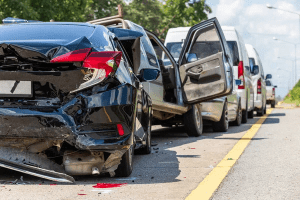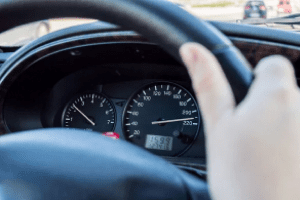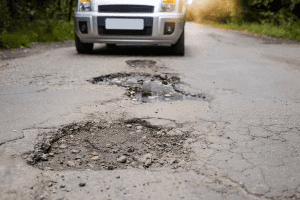
Accidents in Orange County are more than just numbers; they represent real people and real stories. Every crash has an impact, affecting lives, families, and the community at large. Orange County, being a densely populated region, has its own unique set of challenges when it comes to road safety.
Auto accidents and pedestrian accidents are common in the local area. These car crashes can even lead to fatal accidents. At Marcereau Law Group, we fight for common car crash victims. We also represent family members of motor vehicle fatalities.
Our personal injury attorney can champion your case as well. After motor vehicle crashes, remember to seek medical care as soon as possible. Then, give us a call to schedule a free consultation.
It is difficult to say exactly how many accidents occur in Orange County annually. However, CA has reported more than 4,000 fatal accidents in 2021 alone. With a mix of urban, suburban, and coastal regions, the county sees a diverse range of accidents. From parking lot taps to severe crashes on highways, the scope is broad. These incidents remind us of the constant need for vigilance on the roads.
Not every accident results in severe injuries or fatalities, but each has consequences. The aftermath can be taxing, whether it’s vehicle damage, insurance claims, or psychological trauma. These accidents burden the victims and put a strain on emergency services and the healthcare system.

Rear-end collisions are the most common type of accident. These often occur due to inattention, sudden stops, or tailgating. Side-impact or “T-bone” collisions are also frequent, especially at intersections where drivers might run red lights or fail to yield.
It is also important to highlight the role that drunk driving plays in local accidents. Alcohol and drunk driving traffic-related deaths are common in California. The CDC reports that about 1,000 people are killed per year in drunk driving crashes. This is a major issue that deserves everyone’s attention.
Over the past few years, there’s been a fluctuating trend in car accidents in Orange County. In general, rush hour periods are the most common time for car accidents. While the morning rush hour from 7 AM to 9 AM sees a major spike in car accidents, the evening rush hour is the biggest. This generally takes place between 4 PM and 7 PM on busy roads in the evening. Drivers might be tired from a long day at work. When combined with road congestion, conditions are ripe for a major car accident.
With the introduction of new road safety measures and vehicle technologies, there were hopes for a consistent decrease. However, increasing population and road usage often offset these benefits.
Certain areas within Orange County see a higher concentration of accidents. Urban areas with dense traffic, like Los Angeles and San Bernardino, often report more collisions. Highways and intersections in these regions tend to be hotspots for accidents.
In addition, areas with more tourists and seasonal events may see spikes during particular times of the year. Understanding these geographic trends is crucial for targeted safety measures.
Several factors play a role in car accidents. While accounting for every variable is impossible, some stand out more than others. By understanding these, both drivers and officials can work toward reducing risks.

Distracted driving is a principal cause of accidents in Orange County. Phones, in-car entertainment systems, or even a simple conversation can divert attention from the road. When drivers lose focus, even for a few seconds, the chances of a mishap increase dramatically.
Although laws exist to curb phone usage while driving, enforcement remains challenging. Moreover, as vehicle technology advances, new forms of distraction emerge. Drivers need to remember the primary task at hand: safe driving.
Driving a vehicle while inebriated or drug-impaired is both illegal and dangerous. Impaired drivers have reduced reaction times, compromised judgment, and blurred vision. In Orange County, DUI incidents are alarmingly high, especially during weekends and holidays.
California law is strict on DUI offenses. California Vehicle Code 23152(b) sets Blood Alcohol Concentration (BAC) limits. However, despite the risks and legal repercussions, some still choose to drive impaired. If you are injured by a drunk driver, reach out to us to schedule a free case consultation.

Speeding reduces the driver’s time to react and increases the severity of accidents. Many accidents in Orange County can be traced back to excessive speed. Some drivers, feeling overconfident or impatient, also engage in reckless maneuvers.
Overtaking in risky situations, tailgating, or ignoring traffic signals are all forms of reckless driving. These behaviors endanger not just the driver but everyone on the road.
While Orange County enjoys fair weather most of the year, occasional rains can make roads slippery. Drivers unaccustomed to wet roads may lose control or fail to anticipate longer stopping distances. Foggy conditions, although rarer, can also reduce visibility and lead to accidents.
Even on sunny days, the glare can pose challenges. Drivers should always adjust to the prevailing weather conditions, reducing speed when necessary and ensuring their vehicle’s lights and wipers function correctly.

Potholes, uneven surfaces, or debris can all lead to accidents. In some parts of Orange County, road maintenance is an ongoing challenge. Drivers need to be vigilant, especially in areas known for poor road conditions.
Furthermore, construction zones or temporary diversions can confuse drivers or create bottlenecks. Respecting signage and speed limits in such areas is crucial to ensure everyone’s safety.
Sometimes, the vehicle itself can be a contributing factor. Mechanical failures, brake issues, or tire blowouts can lead to accidents. Regular maintenance and checks are vital. If there is an automotive defect, the manufacturer could be held responsible.
Additionally, some vehicles have blind spots or design flaws that can hinder driving. It’s essential for drivers to be familiar with their vehicle’s limitations and adjust their driving accordingly.

Accidents vary in severity, from minor scrapes to catastrophic events. Understanding the range of outcomes can provide a clearer picture of the impact on victims and the community.
Tragically, some accidents result in fatalities. These devastating incidents leave families grieving and communities in shock. Every life lost is a reminder of the importance of road safety. If your family member is killed in an accident, we could pursue a wrongful death claim.
Many victims of car accidents escape with mild injuries, like bruises or minor cuts. However, others aren’t so lucky, suffering moderate injuries like fractures or concussions. In severe cases, victims may endure traumatic brain injuries, spinal injuries, or amputations.
Whiplash, due to the sudden back-and-forth movement of the head, is common in rear-end collisions. Broken bones, internal injuries, and lacerations are also frequently reported. More severe accidents might result in burns, paralysis, or life-altering trauma.
The healthcare system faces a significant burden due to car accidents. Emergency rooms often deal with accident victims requiring immediate care. Long-term rehabilitation and therapy are also needed for many, placing a strain on healthcare resources.
Understanding who’s involved in accidents can provide insights into potential risk groups and targeted prevention strategies.
Younger drivers, especially those between 16 and 19, are often involved in accidents due to inexperience or risk-taking behaviors. On the other end, elderly drivers might face challenges due to declining physical or cognitive abilities.
While both genders are involved in accidents, statistics show variations in the types of accidents or behaviors leading to crashes. Men are slightly more likely to be involved in more serious car accidents.
Certain times and locations see a higher frequency of accidents. Being aware of these patterns can help drivers be more cautious and authorities to implement safety measures.
Rush hours, especially in the mornings and late afternoons, see more traffic and, consequently, more accidents. Weekends, with more leisure driving, might also see spikes in certain types of collisions.
As mentioned earlier, urban regions like Anaheim or Santa Ana see more accidents. But specific intersections or stretches of road might be notorious for frequent mishaps. Being aware of these zones can help drivers be extra cautious.
While Orange County enjoys consistent weather, certain seasons might bring unique challenges. For instance, holiday seasons might see more DUI incidents or tourist-heavy summers leading to unfamiliar drivers on the roads.
Preventing accidents is a shared responsibility. Authorities, communities, and individual drivers all play a part.
Campaigns highlighting the dangers of distracted or impaired driving have made a difference. They remind drivers of their responsibilities and the potential consequences of their actions.
Driving schools and community centers offer programs educating new drivers and refreshing the knowledge of older ones. Proper training can make a significant difference.
Improving road infrastructure, from better signage to revamped intersections, can reduce accidents. Properly designed roads can guide traffic flow and reduce congestion points.
Modern vehicles come equipped with safety features like automatic braking, lane departure warnings, and more. These technologies can prevent accidents or reduce their severity.

Car accidents are more than just statistics; they profoundly impact victims’ lives. If you or a loved one has suffered due to an accident in Orange County, it’s essential to seek legal guidance. At Marcereau Law Group, we understand the challenges victims face and are here to help. We have a long track record of successful cases.
Your rights and well-being are our top priority. We’re committed to ensuring you receive the support, guidance, and compensation you deserve. This is reflected in reviews written by prior clients.
Contact us today for a free consultation, and let us be your advocate during this challenging time.
Schedule Your Free Consultation
"*" indicates required fields


"*" indicates required fields